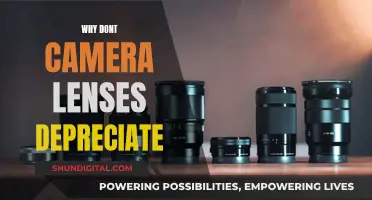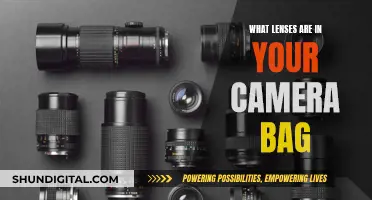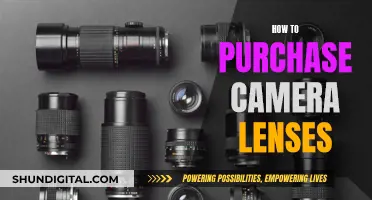
Camera lenses are full of abbreviations, number ranges, and acronyms that can be confusing, especially for beginners. However, understanding these specifications is essential for photographers to choose the right lens for their needs. The most important specifications to look for are focal length, aperture, and image stabilization.
The focal length of a lens, usually written in millimetres, indicates the range of the lens, with the bigger the number, the narrower the angle of view. Lenses with a longer focal length will make subjects appear closer, while a shorter focal length will capture more of the subject.
The aperture, or maximum aperture, is the part of the lens that controls the amount of light that reaches the camera sensor. A wider aperture, like f/1.8, lets in more light and is better for low-light conditions and portraits, while a smaller aperture, like f/22, lets in less light and is better for well-lit environments.
Image stabilisation is another important feature, as it reduces the effects of camera shake to produce sharper images. This is especially useful for telephoto lenses and shooting in low-light conditions.
Other specifications to consider include the lens diameter, which corresponds to the filter size, and the focusing range, which indicates the minimum and maximum distance the lens can focus on.
By understanding these specifications, photographers can make informed decisions about which lens to use for their desired photographic outcomes.
| Characteristics | Values |
|---|---|
| Focal length | Written in millimeters. Indicates the range of a lens showing its shortest and longest distance. |
| Aperture | Expressed as f-numbers or f-stops. The part of the lens where the amount of light that goes to the camera sensor is controlled. |
| Image Stabilisation | A system that reduces the effects of camera shake for a sharper image. |
| Ultrasonic Motor | Allows for quieter and faster focal adjustments. |
| Lens diameter | Measured in millimeters. |
What You'll Learn

Focal length
Lenses that lack zoom functionality have a single focal length, while zoom lenses use two numbers to indicate the range of a lens's focal length. For example, a zoom lens might have a focal length range of 18-55mm, meaning it can zoom from a relatively wide angle (18mm) to the beginning of the telephoto range (55mm).
The shorter the focal length, the more of the subject you'll be able to capture in a photograph. That's why wide-angle lenses have focal lengths ranging from 10-30mm. Conversely, the longer the focal length, the narrower the area of the scene captured by the lens.
Another important distinction is between prime and zoom lenses. Prime lenses have a fixed focal length, meaning the perspective of the image can only be changed by physically moving the camera closer to or further from the subject. Zoom lenses, on the other hand, offer variable focal lengths, providing more convenience and flexibility as you can carry just one lens for a range of shooting situations.
The focal length of a lens also impacts the lens speed or maximum aperture. A lower focal length results in a larger aperture, allowing more light to enter the lens and creating a shallower depth of field.
Additionally, the camera's sensor size can affect the field of view. Smaller sensors, such as APS-C sensors, have a crop factor that makes the image appear more zoomed in. This changes the effective focal length of the lens, making the subject appear larger in the frame.
Choosing the Right Camera Lenses: A Quick Guide
You may want to see also

Aperture
Lenses with low apertures (which allow for more light to hit the sensor) also produce a blurred "bokeh" effect, perfect for portraits. Conversely, a higher aperture like f/22 will add blur throughout your photos and darken them more than you'd normally want.
The maximum aperture is usually indicated in the same manner on every lens. You can usually find this information on the end of the lens barrel or on the front of the lens inside the filter ring area. The maximum aperture will be written as a number followed by "f/" or "f-number". For example, "1:2.8" or "f/2.8" means the maximum aperture of the lens is f/2.8.
If you are using a zoom lens, you will see a maximum aperture range, like f/3.5-4.5. This means that the lens has a maximum aperture of f/3.5 at its widest angle, and f/4.5 when fully zoomed in. The more you zoom in, the smaller the maximum aperture and the higher the aperture number.
If you see a range of numbers after the slash, like "18-55mm f/3.5-5.6", that means the lens has a variable aperture and will have a different maximum aperture at its wide-angle and telephoto ends. These are called "variable aperture" or "zoom" lenses.
When comparing lenses, it's important to note that the smaller the f-number, the more light the lens lets through, and the more easily it can take pictures in low-light conditions. Lenses with better lens speed (smaller f-number) tend to be larger, heavier, and more expensive.
Interchangeable Lenses: Mirrorless Camera Flexibility Explored
You may want to see also

Lens mount
A lens mount is a mechanical device that attaches a lens to a camera body. It is the interface between a camera body and a lens and allows for interchangeable lenses.
There are different types of lens mounts, with the most common being screw-threaded and bayonet types. Screw-threaded mounts involve threading the lens onto the camera body, while bayonet mounts use three to four tabs to lock the lens in place. Bayonet mounts have been the standard for most modern lenses.
Different camera manufacturers have different types of lens mounts. For example, Canon has four different types of lens mounts: RF, RF-S, EF, EF-S, and EF-M. Nikon, on the other hand, has a simple bayonet mount that has remained the same since the introduction of their first SLR, the F. However, their oldest "non-ai" lenses will not fit modern DSLR cameras.
When choosing a lens, it is important to consider the lens mount to ensure compatibility with your camera body. Different camera models from the same manufacturer may also have different lens mounts, so it is crucial to check the specifications before purchasing a lens.
Additionally, some lenses are designed for specific sensor sizes, and using them on a camera with a different sensor size may result in incompatibility issues or reduced image quality.
In summary, the lens mount is a critical component that ensures the lens can be securely attached to the camera body, and it plays a significant role in determining the compatibility and performance of the lens and camera system.
Lens and Camera Compatibility: Are Lenses Camera-Specific?
You may want to see also

Image stabilisation
Different Terms for Image Stabilisation
Different camera manufacturers use different terms to refer to image stabilisation:
- Canon: Image Stabilisation (IS)
- Nikon: Vibration Reduction (VR)
- Sony: Optical SteadyShot (OSS), Optical SteadyShot Image Stabilisation (O.S.S)
- Sigma: Optical Stabilisation (OS)
- Tamron: Vibration Compensation (VC)
- Tokina: Vibration Correction Module (VCM)
Stops of Stabilisation
Lens Stabilisation vs In-Body Image Stabilisation
There are two types of image stabilisation: lens stabilisation and in-body image stabilisation (IBIS). Lens stabilisation is found in the lens itself, while IBIS is a feature built into the camera body. IBIS moves the camera sensor along various axes to compensate for camera movement. Both types of stabilisation can be used together and often provide even better stabilisation when combined.
Should You Get a Lens or Camera with Image Stabilisation?
Whether or not you need image stabilisation depends on your shooting conditions and preferences. If you often shoot in low-light conditions or with longer lenses, image stabilisation can be extremely beneficial as it allows you to use slower shutter speeds while still achieving sharp images. However, if you primarily shoot in good lighting conditions or with a tripod, you may not need image stabilisation.
Buying Camera Lenses: Strategies to Save Money
You may want to see also

Lens diameter
The lens diameter is the physical measurement of the diameter of the front-most part of the lens. It is different from focal length and aperture. The lens diameter is often threaded to allow filters and lens hoods to screw in.
The lens diameter is usually marked on the lens using the symbol "ø" followed by a number (e.g. ø52 for 52mm). If it is not marked, you can measure the widest part of the lens or refer to the lens specifications.
There is no set standard for lens diameter size, but there are some common sizes for the diameter of DSLR lenses: 43mm, 49mm, 52mm, 44mm, 58mm, 62mm, 68mm, 72mm, and 77mm.
The larger the lens diameter, the more light that can enter, and the larger the lens elements that can be used internally. This can potentially contribute to better optical quality, with less light fall-off at the edges (vignetting) and potentially sharper images at wide apertures.
Wide-angle and long telephoto lenses tend to have larger lens diameters, the former to allow a wider perspective of the scene, and the latter to allow more light to enter.
Lenses designed for full-frame cameras tend to have larger lens diameters than those designed for cropped-sensor bodies. Lenses for smaller sensors, like Micro Four Thirds, are typically smaller still.
Understanding the Reach of 800mm Camera Lenses
You may want to see also
Frequently asked questions
The focal length of a camera lens is the distance from the lens's most focused image to the camera's sensor. It is written in millimetres and is usually found on the lens along with the lens aperture number. The focal length number can be a single number for lenses that lack zoom functionality, or a range of two numbers for zoom lenses. The smaller the focal length, the more of the subject you will be able to capture in a photograph.
The aperture of a camera lens refers to the amount of light that is allowed to reach the camera's sensor. It is measured in "f-numbers" or "f-stops" and is usually indicated in the same manner on every lens. The aperture range can vary anywhere from f/1.0 to f/22 depending on the lens. The lower the f-number, the wider the opening, and the more light the lens lets in.
The lens diameter, also known as the filter size, is the distance across the centre of the lens. It is measured in millimetres and can be found on the end of the lens, often on the edge of the barrel, preceded by a symbol that looks like a zero with a strike-through. The lens diameter is important for attaching filters to the camera lens.







